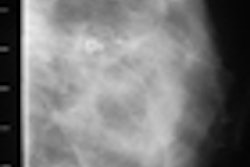CHICAGO - The 2009 decision by the U.S. Preventive Services Task Force (USPSTF) to change its guidelines on screening mammography continues to echo throughout women's health, according to research presented Monday at the American Roentgen Ray Society (ARRS) meeting.
Several ARRS studies addressed the controversial guideline change from multiple angles, with one study finding that cancers are being detected at earlier stages in women who get screened compared to those who don't. Another study found that physicians have been referring fewer women to mammography since 2009, both in the 40-to-49 age group and in older age cohorts.
Dr. Donna Plecha, of University Hospitals Case Medical Center in Cleveland, and colleagues found that not screening women between the ages of 40 and 49 means missing in situ and advanced-stage cancers. This results in lower survival rates for the disease, according to medical student Mallory Kremer, who presented the study.
"Screening mammography identifies breast cancer at earlier stages, which translates into reduced mortality," Kremer said. "But with the changes in the USPSTF screening guidelines, alterations in referring physician practices, and existing overall poor patient adherence to screening protocols, survival rates will decline."
The group gathered data from biopsy-proven breast cancer and high-risk lesions in patients between the ages of 40 and 49 who were diagnosed between January 2008 and December 2009. Of 511 breast biopsies performed during the time period, there were 108 primary breast cancers, Kremer said: 71 of these were found in patients who had received screening, and 37 were found in patients who had not (and had instead presented for a mammogram because of symptoms).
But most significant was the kind of cancers that screening found, Kremer said.
"Nearly one-third of patients in the screened group were diagnosed with ductal carcinoma in situ, compared with less than 5% of patients in the not-screened group," she said.
And when the group considered only the invasive cancers found in the cohort, it became clear that women in the screened group were better off.
"When we considered only invasive cancers, we found that, stage for stage, it was better to be in the screened group," Kremer said. "Nearly half of screened patients presented with stage I cancer, compared with a quarter of not-screened patients."
In a related study, Dr. Lara Hardesty, of the University of Colorado, and colleagues gauged the effects of the USPSTF's recommendations on patient decisions. The group compared screening rates for women 40 to 49 years of age in the nine-month period before the USPSTF's guidelines were released with rates in the nine-month period after they were released.
The researchers found a 15% decline in screening for these women between the two time periods. Hardesty attributed the drop in part to the medical decisions made by the patients themselves.
"It's likely that the reduction is in part because of patients' own decisions, made from listening to media coverage [of the USPSTF's screening mammography recommendations]," she said. "At our institution, patients don't need an order to get a mammogram. So if they hear on TV that they don't need one, they may not discuss it further with their doctor."
Changing physician ordering patterns
The USPSTF screening mammography guidelines have also changed the exam ordering practices of primary care doctors, adding even more complexity to the problem, according to Dr. Jayme Takahashi, also at the University of Colorado, who presented at the session.
Takahashi's group queried 303 primary care physicians via an anonymous electronic survey about their screening mammography ordering practices in each of three patient age groups (40 to 49, 50 to 74, and older than 74) before and after the release of the USPSTF guidelines. The clinical makeup of the respondents was 59% internists, 27% family practitioners, and 14% gynecologists.
Takahashi's team found that clinician ordering practices changed significantly, particularly in the 40-to-49 and older-than-74 age groups. The USPSTF had advised against screening mammography in the former population and stated there was insufficient evidence for screening mammography in the latter population.
Screening recommendations, pre and post 2009 USPSTF guidelines
|
"Now that the USPSTF recommendations have been released, there are more discussions occurring between women and their clinicians about screening mammography," Takahashi said. "And there are fewer annual screening mammograms, which means fewer false positives. But it also means less cancer detection."
Is resistance futile?
Resistance to screening mammography is baffling but not new, according to the keynote speaker for the session, Dr. Carol Lee from Memorial Sloan-Kettering Cancer Center. But the evidence will continue to speak for itself.
"It's puzzling that despite all the evidence -- starting with the Health Insurance Plan of New York's 1960 effort that included 60,000 women -- there are continuing attacks on screening for breast cancer in this country," Lee told attendees.



















